(This is the final post in a four-part series. You can see Part One , Part Two , and Part Three .)
The new question-of-the-week is:
What are specific ways to make lessons more culturally responsive and culturally sustaining?
In , Dr. Rocio del Castillo, Dr. Julia Stearns Cloat, Lisa Stringfellow, Valentina Gonzalez, Maurice McDavid, and Cathery Yeh shared their suggestions. You can listen to a I had with Rocio, Lisa, Valentina, and Maurice on . You can also find a list of, and links to,
In , Nadine Sanchez, Guadalupe Carrasco Cardona, Jessica Torres, Michelle Knight-Manuel, Joanne Marciano, Paula J. Mellom, Rebecca K. Hixon, Jodi P. Weber, Shawn Wooton, and Dawn Mitchell contributed their commentaries.
In , Kaitlin Popielarz, Sean Ruday, Laura Mitchell, Ed.D., Dr. Laura Greenstein, and Keisha Rembert provided their ideas.
Today, this series is being “wrapped up” by Barbara Leilani Brazil Keys, Altagracia H. Delgado, Saroja Warner, Amanda Branscombe, and Becky Corr.
The next question-of-the-week can also be found at the bottom of this post.
Three reflective questions for culturally responsive teaching
Barbara Leilani Brazil Keys taught for 15 years in Oakland, Calif.; Honolulu; and Charlottesville, Va., before taking a position as an educational equity specialist in the Albemarle County public schools, in Virginia. Alongside a team of committed educators, she currently helps teachers refine their instructional practices for the purpose of achieving equitable outcomes for all students through Culturally Responsive Education:
The education world is trending with the term “Culturally Responsive Teaching” right now, but the concept of teaching that is relevant to our students’ home cultures is age-old! I received my best lessons in Culturally Responsive Teaching when I went home to Hawai’i to teach students in an indigenous charter school on Oah’u. Student learning was steeped in culture, from the foundation of the science curriculum, which embedded traditional Hawaiian ecological practices, to the social studies lessons, which incorporated comparisons of world cultures to Hawaiian indigenous culture. This curricular approach made Culturally Responsive Teaching truly culturally sustaining because it did not ask students to leave their own cultures at home. 69��ý could be who they truly are when they entered the school each morning, learning in ways that empowered them culturally.
Years later, after moving to teach on the East Coast, my application of Culturally Responsive Teaching took on a new meaning. Not only was I faced with a more culturally heterogeneous group of students and families to learn about and from, I was also impacted by the lack of academic success of many of my students of color, students who, not unlike the indigenous students that I taught in Hawai’i, were eager to express themselves culturally. However, my new students were often hindered by well-meaning educators who did not relate to their students’ cultural meaning-making or expressions of cultural pride.
Though I recognized the need for Culturally Responsive Teaching in my own secondary classroom, I felt pressure to address numerous academic standards in a short time, and, more difficult to admit, I felt disconnected to the cultures of my students and the region in which I was teaching. I resorted to quick-fix strategies to make my lessons more relevant and more engaging. However, the gains made by employing various “strategies” were not impacting long-term academic outcomes. As I sought methods that would be more culturally sustaining, I realized I had to make a commitment to teaching that would embed students’ home cultures into my whole curriculum, while guiding students toward academic success. I used reflective questions to consider the ways my teaching was addressing, or failing, my students’ cultural needs as learners. Here are those questions with three tips for applying CRT in your own classroom or context:
Are my class rules and expectations culturally empowering to my students? First, acknowledge your own culture and consider how it is different from your students’ cultures. Reflect on your upbringing and the values that your family and community passed down to you. Take it a step further by analyzing your core values and how they manifest in your teaching. What are the rules and non-negotiables in your classroom, for instance? In your estimation, what does it look like to be a “good student?” Your answers to these questions are deeply embedded in your cultural background. Could the cultural norms that you have created in your classroom be dissonant to your students, creating a cultural divide of you may not be aware? Make your classroom norms more inclusive so they are not stifling to students whose cultures are different than yours. This can be done by guiding students to create a set of classroom expectations together, drawing upon what expectations work for families at home.
Am I teaching in a way that my students learn best? To make our instruction relevant to our students, we have to think about the way they learn, not get stuck in the way we learn. A teacher recently told me that her student’s house was so loud that she didn’t know how he could learn at home. Perhaps this teacher’s way of learning isn’t the way this student learns with his family: cross-talking, summarizing various perspectives, and coming to conclusions, which are then challenged by his family members. This student may synthesize oral information at a faster rate than you are teaching content and be bored in class!
- Am I being a cultural ally to my students in support of their academic success? Begin to develop alliances with your students by authentically getting to know them better. Build trust by following through and validating when they express feelings of injustice, unfairness, or feelings of unworthiness. Create alliances with students around academic goals that they are interested in accomplishing. Pinpoint and often celebrate their successes so that they build trust in you and confidence that they can reach their goals. Do this by meeting with students regularly, having personal conversations with them, and giving them one-on-one attention.
Culturally responsive teaching is not a quick fix, nor is it a simple strategy to add into your lessons. It takes reflection upon your and your students’ cultural lenses. It takes an inquiry stance and an audit of practices that may be limiting student access to your curriculum. Above all, it takes a deep connection with students and their families, and a commitment to support their cultural needs, even if what is required is for you get outside of your cultural comfort zone.
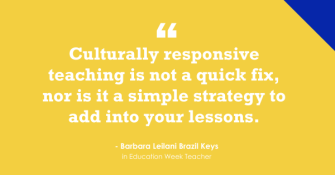
Restorative Circles with children’s literature
Altagracia H. Delgado has been in education for 24 years and currently works as the director of language acquisition and early childhood in the Brazosport Independent school district, in Texas:
Classroom environment is one of the most important areas a teacher must address. It sets the tone for the time students will spend together and it should be one that it is supportive to all. Lately, we have seen a push for more culturally responsive classrooms that embrace acceptance and inclusion of all students. Putting practices in place to ensure this happens can be daunting for many teachers. Accepting and understanding one’s biases must be a first step in order to get out of our comfort zones and ensure that our students feel accepted and included in all aspects of the instructional process.
One project that we have started at my school district in order to address culturally responsiveness in the classroom is through the use of restorative-circle practices with the support of children’s literature. Allow me to explain. Particularly in our secondary classrooms, we have seen a great deal of disengagement in students’ classroom participation due to many factors including the age group, peer pressure, difficulties to communicate in new languages, and a lack of representation in classrooms texts. Based on this, the idea to use restorative circles as a medium for classroom conversations and language development was created. The structure of circles allows for students to engage in a safe space for discussion, but we needed an anchor to help with the process; something to engage students in a more meaningful way.
We decided to anchor our conversations in culturally relevant children’s books with which students could relate. For example, using the book Alma and How She Got Her Name, by Juana Martinez, students were able to engage in conversations about belonging to cultures with different pronunciations of names and how those names connect us to family members near and far. In addition, the value of correct pronunciation of one’s name became relevant because names are important to one’s identity, and as such, they should be respected. This conversation opened doors in a classroom community that houses multiple native languages and helped in building a community of support for these students. The books stay in class so students can reflect on these stories, while helping them develop a language that may not be their first. Once these connections have been established, additional ones can be created through music, food, and the sharing of common experiences. In this manner, everyone’s culture has a space and is appreciated and respected in the larger community.
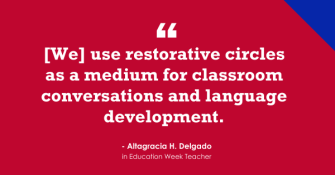
Three strategies for culturally sustaining teaching
Saroja Warner works as a senior state technical-assistance director in Learning Innovations and co-director of the where she helps build the capacity of states and school districts to develop and successfully implement education policy and practices to support equitable and positive outcomes for all learners. is a nonpartisan, nonprofit research, development, and service agency working with education and other communities throughout the United States and abroad to improve education and other important outcomes for children, youths, and adults:
There are no quick tricks for ensuring that your lessons are culturally responsive and sustaining, but the process starts by making sure that you ARE a culturally responsive and culturally sustaining teacher. How do you do that? I’ve learned some valuable lessons over the course of my 15-year teaching career and offer the following suggestions.
Grow your knowledge base. You cannot create culturally responsive and sustaining lessons until you understand what it means to be a culturally responsive and sustaining teacher. Becoming familiar with the work of Gloria Ladson Billings, Geneva Gay, Zaretta Hammond, and Django Paris are a perfect place to start.
Collectively, they describe culturally responsive and sustaining teachers as those who:
- believe all students can learn and hold high expectations for each student;
- have deep content knowledge about the subjects they teach;
- understand the cultural experiences and expressions of their students, their histories, and the communities in which they teach and draw from that knowledge and understanding to develop learning opportunities that validate students’ lived realities, cultural identities, and heritage;
- are reflective practitioners routinely examining their own life experiences, cultural knowledge, and explicit and implicit biases; and
- support students’ ability to recognize, understand, and critique both historical and current social inequalities.
I recommend adding the following books to your library:
- The Dreamkeepers: Successful Teaching for African American 69��ý by Gloria Ladson-Billings
- Culturally Responsive Teaching: Theory, Research, and Practice by Geneva Gay
- Culturally Responsive Teaching and the Brain: Promoting Authentic Engagement and Rigor among Culturally and Linguistically Diverse 69��ý by Zaretta L. Hammond
- Culturally Sustaining Pedagogies: Teaching and Learning for Justice in a Changing World by Django Paris (Editor), H. Samy Alim
Of utmost importance is to keep learning—both about the content you teach and how to make it relevant to your students. Remember that culturally responsive and culturally sustaining teaching is rigorous and relevant.
Plan lessons with students and culture in mind. Begin lesson planning by considering who your students are: where they live, what language(s) they speak at home and in the community, how they identify themselves, what their learning styles and needs are. Do your recon to really know your students. Some intelligence-gathering can be done by just paying attention to students and what is happening in their world. Another way is to talk with them, their families, and members of the community. Remember that the most effective teachers are able to draw on students’ prior knowledge, experiences, and culture to connect students to and help them learn new ideas, concepts, and information.
Create options for students. Adapt instruction to meet your students’ diverse needs and interests. In lesson planning, explore ways to accommodate this diversity by creating multiple paths for students to learn new content as well as demonstrate their learning. One framework for increasing student choice and autonomy while ensuring rigor, relevance, and authenticity in your lessons is the . With its focus on providing multiple means of engagement, representation, and actions and expression, it offers strong guidance for creating culturally responsive and sustaining learning experiences.
Engage in culturally responsive data use. Culturally responsive teachers are data literate. Data literacy is broader than assessment literacy. As noted in , by Ellen Mandinach and Edith Gummer, data-literate teachers transform information into actionable instructional knowledge and practices. These teachers collect, analyze, and interpret all types of data, not just assessment results, to help determine instructional steps that will advance student learning. Culturally responsive teachers look for, gather, and analyze a variety of culturally relevant data to advance student learning. This includes information about students’ personal and lived experiences, learning styles, the culture of the communities where they live, attendance, and student behaviors, to name a few. Culturally responsive data use allows teachers to triage information to design rigorous and relevant lessons for diverse students.
In sum, making lessons more culturally responsive and sustaining starts with learning what it means, in both practice and mindset, to be a culturally responsive and culturally sustaining teacher, and committing to reflective practice and growth. I encourage you to check out that was developed by the to support teachers’ reflective practice and to guide professional learning and development of eight core competencies for culturally responsive teaching. Shout out to New America for the from which this tool was adapted.
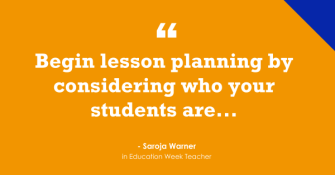
Sharing stories
Dr. Amanda Branscombe is an associate professor at Athens State University in Athens, Ala. Her research interests include play, young children’s early writing, social justice, and teacher education. Before beginning her career in teacher education, she directed child-development centers and taught at the kindergarten and secondary education levels:
I suggest that teachers create learning environments that welcome the conversations, questions, and stories of multiple voices. In addition, teachers should help learners engage in the subject matter that they, the learners, wish to pursue as well as the means that they want to use to explore that content. How do such learning environments develop? I offer a brief overview of three approaches for teachers and their students to consider: an inquiry stance for teacher/student research; shared journal stories; and innovative partnerships. In many respects, these approaches guide teachers in sorting out teaching and learning throughout their careers.
Learning environments emerge when teachers take on an inquiry stance and begin using their funds of knowledge—their “already existing” teaching experiences and practices—as information or data for researching the teaching and learning that is happening in their classrooms (Berthoff, 1987; Lankshear & Knobel, 2004; Rust, 2018). That information can be in the form of questions and stories as learners attempt to make sense of their experiences. Whatever the form, it has conversation, inquiry, and reflection that deepen the learners’ knowing about who they are and what they know. Berthoff (1987) calls it “re-searching” or making sense of the information that they generate about the subject matter and themselves as learners.
I recommend inquiry-based teacher research as a way of looking at culturally responsive and sustaining teaching because it allowed me to see the complexity of my own teaching and learning environment.
My first inquiry-based research study with my 9th grade students who were labeled as remedial predelinquents and Shirley Brice Heath, whom I had the privilege of having as a teacher at Bread Loaf School of English. Because I viewed myself as an advocate for social justice, I questioned the school’s view of my troublemakers and potential dropouts. I questioned my understanding of the students’ definition of literacy. Heath and I had them make a list of the kinds of literacy that they encountered every day. Needless to say, they defined literacy as the texts on cereal boxes, beer cans, eviction notices, etc.. After this project, the students posed their question: “How are we supposed to make sense out of literacy in this ‘rich folks’ school?” These questions led to deeper and more complex questions that the students initiated. I set up a pen pal writing exchange with students in advanced, “rich folk” classes to help the students answer those and other questions. In addition to the pen pal project ,the students, Heath, and I did investigations on Shakespeare and rap music, the language of baseball, and reading stories to toddlers (Heath, 1984; Heath & Branscombe, 1985; Heath and Branscombe, 1986).
That first research project and becoming-a-teacher researcher caused me to begin to understand the seditious role cultural power plays in teaching and learning.
The second approach, the Shared Journal Process (Taylor, Branscombe, Burcham, and Land, 2011), was developed by Taylor and several kindergarten teachers. The approach involved having three students share a true story from their lives each day. The other students would listen, ask questions to learn more about the facts of the stories, and then decide which story would best represent the history of their lives during that school year. After the sharing, students would write and draw in their journals about a story. The students were in charge of the sharing event even though teachers monitored. Often they asked the storyteller to speak louder or reminded him/her that the story had to be true. As one boy said to the storyteller, “I go by your house every day on the bus, and you don’t have a new swimming pool.” At the end of the month, each student’s set of stories was placed in the class library so that they and others could read those stories.
This shared-journal process really created what Bishop (2011) described as creating windows and mirrors in the classroom. The children’s Shared Journal stories became windows and mirrors into their lives. “The mirror reflects the life of the child and includes context-specific references to the things they experience and the surrounding community where they live. Windows are openings to the world around learners and include consideration of all things that are possible in the world today.” (Catapano, 2018, p. 45).
The Shared Journal Process values the student’s voice, celebrates the students’ culture, and even welcomes it into the classroom. Not all teachers embrace this process. They fear that it breaks down the social and cultural barriers within a classroom. Interestingly enough, parents and guardians value it because they learn about their children’s lives.
The third approach is for teachers to participate in projects outside of their classrooms to help them remember that they are part of a larger network. Although this approach may seem to be more appropriate for teacher educators, it allows classroom teachers to tell their stories and share their research. It allows them to be experts who can point out how the project could help them become more of a force to address culturally responsive and culturally responsive teaching. It reminds them that their work is important. Finally, it helps them mentor new teachers into teaching. Dr. Prentice Chandler, dean of the Eriksson College of Education at Austin Peay State University, and Dr. Sean Impeartice at the Clarksville-Montgomery County School System (CMCSS) recognized the crisis of keeping teachers in school systems in their communities. They are initiating a project that targets 20 CMCSS teacher aides and 20 recent high school graduates who all are first generation and minority students. The project then provides them with an accelerated, free path to becoming a full-time school system teacher in three years. for more information.
These three approaches alone will not offer teachers culturally responsive and sustaining classrooms. They require that teachers engage in the complexity of teaching and learning. They require that teachers have the courage to face themselves, their students, and the learning environments that they’ve created. The approaches require that teachers ask hard questions about privilege, culture, and what we want for the students. By engaging in the questioning and reflecting, teachers and students begin to examine the complexity of what it means to be culturally responsive and participate in a culturally sustaining learning environment.
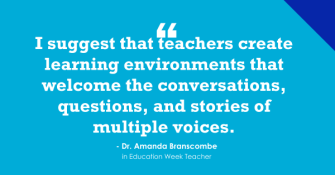
“Practical ways to make lessons more culturally responsive”
Becky Corr is the president of EdSpark Consulting, which is dedicated to igniting partnerships for diverse learners through professional development, technical writing, and systems analysis. In her role as an the English-language-development team lead in the Douglas County school district in Colorado, she coaches, mentors, and supports teachers and facilitates family-engagement opportunities:
OK, I have to confess. In preparation for writing my response to this question, I had to do a little research. I’ve studied and utilized culturally responsive teaching in my classroom, but I wasn’t sure what “culturally sustaining” meant. Luckily, Larry Ferlazzo has a blog post for that! with Django Paris helped me to clarify CRT and CST. What I noticed is that the overarching theme of CST was an asset- based approach. The asset-based approach aligns with WIDA’s Can-Do philosophy and the new .
So, what are some practical ways to make lessons more culturally responsive? Start by preparing yourself.
- Examine your own assumptions and biases. This is a very important part of the process. It uncovers areas of growth and opens opportunities to engage in culturally responsive teaching.
- Be open to new approaches. What worked for your own personal education may or may not work in your current setting.
- View cultural and linguistic diversity as an asset. Value all
- Get to know your students and their families. has some great tips.
- Research the linguistic and cultural diversity represented in your class. Author Jeffra Flaitz that can serve as a jumping-off point for starting conversations and asking questions about students’ cultures. Keep in mind students’ backgrounds are different, even if they are from the same country. These books are a starting point for beginning to understand culture on a deeper level.
These practices should not only occur in the classroom on holidays or heritage months. Culturally responsive practices are a guiding value or North Star by which a teacher charts the course; they are infused into classroom routines, everyday practices, and intentionally woven into lessons. Below are some practical ideas:
Invite families into the classroom. Asking parents to read books or tell a story in their language can be the start of a great partnership. Inviting parents to view student work or presentations and celebrate their child’s success is a great place to start.
Play music from students’ home countries. Many teachers play music as students enter the room, to facilitate an activity, or as students leave. If you are concerned about appropriate lyrics, you can usually do a quick Google search to find the lyrics in English or use Google Translate to get a good idea of the content of the songs.
Intentionally plan for students to use their home languages in the classroom. You can choose to group students with the same language background together. Or, if students in your class do not share a common language, they may gain an appreciation for the linguistic abilities of their classmates as they listen.
Consider the cultural values of your students when planning a lesson. Are you asking students to do something contrary to their deep cultural beliefs? For example, in many cultures, it is disrespectful for a student to tell the teacher that they don’t understand something. It reflects poorly on the teacher that the student doesn’t understand. So, if I ask students to self-assess their learning, some students might be reluctant because they do not want to critique the teacher. Instead, ask students to evaluate their effort or provide a performance task so that students can demonstrate their learning.
Consider the cultural practices that you can bring into your classroom. Do your students value community over individuals? Do they value individuals over community? Getting to know their deep beliefs will help you to design lessons that play to the strengths and deep beliefs of your students.
- Make sure that your students’ cultures are represented on the walls and within the physical space of your classroom. It is very important that students take ownership of the classroom space. Displaying student work and artwork from their cultures provides students with a safe and welcoming environment that they can thrive in.
Honoring and celebrating all cultures provides a safe environment for students to challenge themselves and be challenged, to take the necessary academic risks, and to be successful. The culturally responsive classroom helps children to appreciate cultural and linguistic diversity and to grow to be culturally proficient adults.

Next Question!
The next question-of-the-week is:
Who was your favorite teacher when you were attending school and why was she/he your favorite?
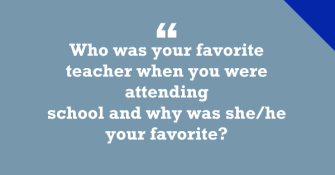
Thanks to Altagracia, Barbara, Saroja, Amanda, and Becky for their contributions!
Please feel free to leave a comment with your reactions to the topic or directly to anything that has been said in this post.
Consider contributing a question to be answered in a future post. You can send one to me at lferlazzo@epe.org. When you send it in, let me know if I can use your real name if it’s selected or if you’d prefer remaining anonymous and have a pseudonym in mind.
You can also contact me on Twitter at .
Education Week has published a collection of posts from this blog, along with new material, in an e-book form. It’s titled .
Just a reminder; you can subscribe and receive updates from this blog via or And if you missed any of the highlights from the first eight years of this blog, you can see a categorized list below. The list doesn’t include ones from this current year, but you can find those by clicking on the “answers” category found in the sidebar.
I am also creating a .
